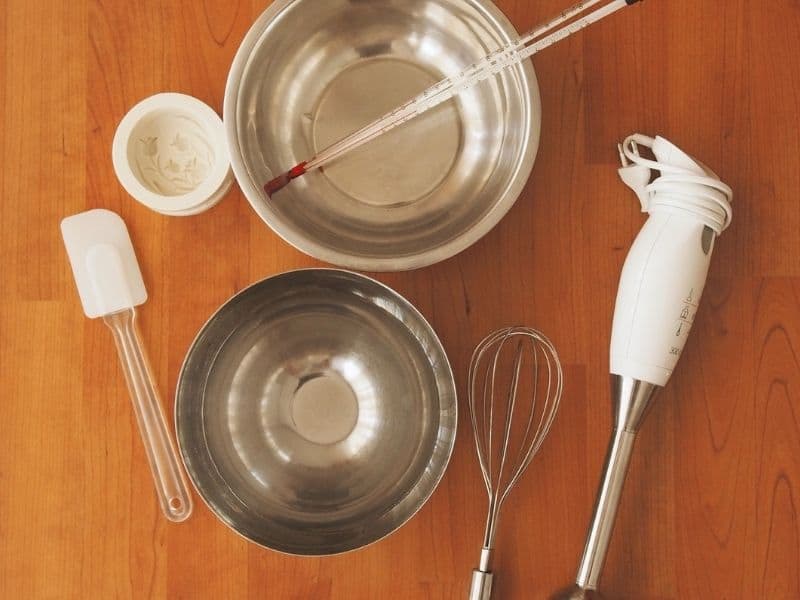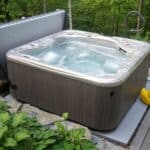Making soap is a fun, easy way to get creative with something we all use or even make some money by selling it. However, you must clean your soap-making equipment properly so that you don’t contaminate your soap with bacteria or harmful chemicals. This article will show you how to clean soap-making equipment quickly and easily.
How To Clean Soap Making Equipment
Let’s take a look at how you can efficiently clean your soap-making equipment.
1) Wipe The Equipment Down
The first step is to take a clean, dry cloth and wipe down all of your soap-making equipment. This will remove any of the soap mixtures before it has a chance to harden.
It is important to remove as much of the soap as you can while it is still soft because once it hardens it will be more difficult to remove from your equipment. It can be very difficult to remove it from all of the little nooks and crannies of your blender or whisk.
2) Put The Equipment In the Sink (Not Scales and Blender!)
The next step is to put your soap-making equipment in the sink. Don’t put your scale or blender in the sink, as they are electric and could be damaged. Wipe them down the best you can and then finish them with a damp sponge.
If you have a dishwasher, you can also put your equipment in there to clean it. However, make sure that all of the soap is removed before you put it in the dishwasher.
Sometimes even a dishwasher can miss a spot or not be able to power through the soap slurry that can get caked onto soap-making equipment.
3) Wash With Soap And Water
I like to use hot water and dawn dish detergent for washing anything in my sink. Whenever you make soaps, bath bombs, and the like, you work with a lot of oils and greasy compounds. Dawn is great at cutting through those!
Once you have hand washed your equipment you can now place it into the dish washer for good measure. It should be able to easily clean up whatever is left.
4) Dry The Equipment Thoroughly
Make sure that your equipment is dried thoroughly. I like to set mine out on a towel or clean the dishcloth and let it air dry.
You don’t want to put soap-making equipment away wet because it can promote the growth of mold or mildew. In the case of a whisk or a blender, if any metal is exposed it can even create an opportunity for rest if any nonstainless steel is exposed.
5) Put The Equipment Away
Now that your soap-making equipment is clean, dry, and ready to use again you can put it away. I like to keep mine in a kitchen cabinet, I usually put it in a bag to keep any dust or dirt from accumulating between soap-making sessions.
Alternate Equipment Cleaning Method
An alternate method some people like is to just let the soap harden on their equipment. Some people stand by this method. The soap can be a bit easier to pop off once it has dried.
When the soap gets dry you can easily pry it off and peel it away from your equipment, however, you will end up washing the equipment anyway.
Sometimes you end up having to soap stuff in hot water so that the soap can soften up and be washed away.
It comes down to personal preference.
I like getting everything over with right from the start, rather than putting it off for later.
Soap Cleaning Equipment Tips
Use Alcohol
Regardless of which method you use it is a good idea to wipe the equipment down with alcohol once it has been cleaned. This will help make sure all of the potentially oily surfaces and residues are gone.
70% isopropyl alcohol is a good choice and can be found at any drug store.
Just use a clean cloth to wipe everything down, taking care to get into all of the nooks and crannies.
Pack It Up
Make sure to put your equipment in a bag or in a box to keep dust, dirt, hair, and debris from settling on it over time as it sits around.
This is especially important for electric equipment like blenders and soap molds.
You don’t want anything getting into the inner workings and ruining your soap-making equipment! Imagine making a batch of soap and finding out you had some unnoticed cat hair in your molds! Yikes!
Cleaning soap-making equipment doesn’t have to be a difficult task. By following these simple steps you can easily keep your soap-making equipment clean and ready to use every time.
This will help ensure that your soap-making equipment is as clean as possible and ready for your next soap-making adventure!
Now that you know how to clean soap-making equipment, you are ready to get started on your next batch of homemade soap!
Frequently Asked Questions
You can hand wash your soap-making equipment using hot water and soap. You can also use an alternate method of letting the soap harden and then prying it off or using alcohol to clean the surfaces.
There are alternate methods for cleaning soap-making equipment, but using soap is generally the most effective way to clean everything completely.
If your equipment isn’t stainless steel you should be especially careful in choosing a cleaning method that won’t damage it. Hand washing is usually the best choice for non-stainless steel soap-making equipment.
You can use bleach, but you should be very careful as it can damage some soap-making equipment. It is also important to make sure that the area is well ventilated when using bleach.
If you can’t get all the soap off, don’t worry! Once the soap is dry it may be a little easier to peel off. Soap-making equipment doesn’t have to be spotless, but it should be clean and dry before being stored away and make sure its clean before using it again.
Conclusion
Cleaning soap-making equipment can seem like a daunting task, but by following these simple steps you can easily keep your soap-making equipment clean and ready to use. Make sure to use soap and hot water to clean everything, and then dry it thoroughly before storing it away.
You can also wipe down your equipment with alcohol to help make sure that all residues are gone. By taking these precautions you can help ensure that your soap-making equipment is as clean as possible and ready for your next batch of soap!






